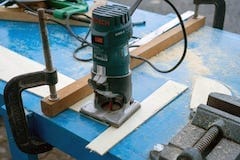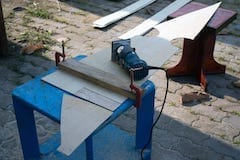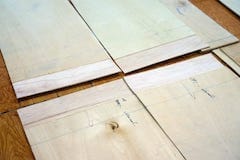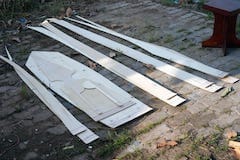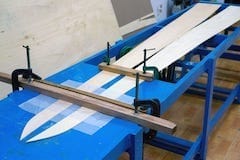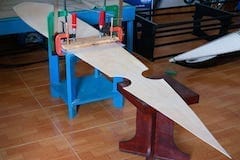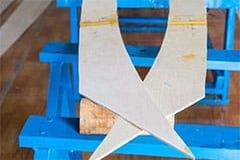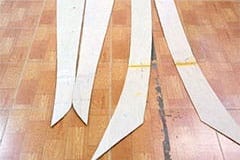Initially, I’d planned to use dovetail joint (or finger joint) to combine the plywood pieces together, but after cutting them, the 4 mm ply is quite thin and fragile to work on, so decided to use scarf joints instead. I used this Bosch laminate trimmer to remove 2 mm of ply on the surfaces, apply the TiteBond 2 glue, then clamp them together overnight. The Bosch fixed base router is an excellent tool, easy to adjust the bit’s depth, small enough to be handled comfortably.
I’ve finished the scarf joints with almost no mistake. Next I would slightly sand the joints, bevel the edges, then apply a few layers of thinned epoxy (epoxy mixed with xylene solvent, that is what they call ‘penetrating epoxy’, more about this in the next post). A layer of fiberglass with un – thinned epoxy over the joints would make the scarf joints strong enough. Some notes about epoxy below, and I hope the information would be useful for anyone having to work with the resin in Vietnam.
There’re several kinds of epoxy resin, the ‘component A’, but for most tasks, the vendors will sell you the correct, most – frequently – used one, just say ‘epoxy resin’ and they will understand. For the ‘component B’, or the hardener, there’re at least 3 types that I know, named (after the local nomenclature): TETA, B5 and T31 (guess they’re the abbreviations of some chemical formulas). The TETA can be called the fast hardener, would cure within a few dozen minutes (in tropical weather).
TETA can be mixed by any ratio from 1/1 to 10/1 by weight (I usually mix in the 2/1 ~ 5/1 range), it produces a very hard but brittle output. The B5 can be called the slow hardener, it takes hours to cure, and need to be mixed at the exact 2/1 ratio. B5 produces a hard, but flexible result, with very little bubbles (but it’s more expensive than the TETA), also it has to be stored in the dark to remain its chemical behaviors. Both has a light ammonia odor. For the T31, I haven’t tried to say anything about it.

